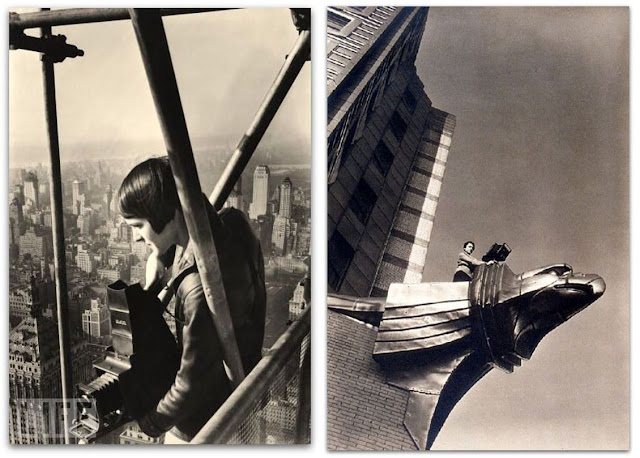
 ♦ Born 1904, begins her career in 1927 as an industrial photographer. She has a talent for capturing the beauty of machinery and the nerve to put herself at risk to get the shot. Young and comely, she becomes known as the "daring girl photographer," and catches the attention of Henry Luce, who hires her in 1936 as the first female photojournalist for his new magazine, Life. (Her picture of Montana's Fort Peck Dam appears on the cover of its first issue, upper right.) The magazine's runaway success adds to her rapidly burgeoning fame.
♦ Born 1904, begins her career in 1927 as an industrial photographer. She has a talent for capturing the beauty of machinery and the nerve to put herself at risk to get the shot. Young and comely, she becomes known as the "daring girl photographer," and catches the attention of Henry Luce, who hires her in 1936 as the first female photojournalist for his new magazine, Life. (Her picture of Montana's Fort Peck Dam appears on the cover of its first issue, upper right.) The magazine's runaway success adds to her rapidly burgeoning fame.
♦ Her subject matter skews gritty ‒ steel mills, oil fields, Soviet farms ‒ and socially conscious. Publishes You Have Seen Their Faces, a book about Southern sharecroppers, with text by her husband, writer Erskine Caldwell.
♦ Covers WWII for Life. Her transport ship to the war zone is torpedoed and sinks, but the ever-resilient Bourke-White survives and goes on to document indelible images of battlefront soldiers and concentration camp inmates.
♦ After the war, she is diagnosed with Parkinson's disease and her output slows. Retires from Time-Life in 1969, passes away in 1971.
Below, iconic portraits of Bourke-White posed precariously on a Chrysler Building gargoyle that cemented her spunky-young-thing persona.
In 1930, Bourke-White leases a 61st-floor work/living space in the Chrysler Building, which includes a terrace abutted by Gargoyle Bill. She hires industrial designer John Vassos to transform it into an art moderne aerie.
In 1934, she leases an apartment in The Woodstock, while still retaining her Chrysler Building work space. We assume living and working in the same space grew tiresome, even if it was the Chrysler Building. It's unclear how long she resides in Tudor City. We suspect she walks to work, she seems the type.
 |
| The gargoyle is a steel rendition of an American eagle. The press name it "Gargoyle Bill." |
 |
| The size of her camera is awe-inspiring. |
⸺⸺⸺⸺⸺
 |
| New York Herald Tribune headline, August 30, 1934 |
In 1930, Bourke-White leases a 61st-floor work/living space in the Chrysler Building, which includes a terrace abutted by Gargoyle Bill. She hires industrial designer John Vassos to transform it into an art moderne aerie.
In 1934, she leases an apartment in The Woodstock, while still retaining her Chrysler Building work space. We assume living and working in the same space grew tiresome, even if it was the Chrysler Building. It's unclear how long she resides in Tudor City. We suspect she walks to work, she seems the type.

No comments:
Post a Comment